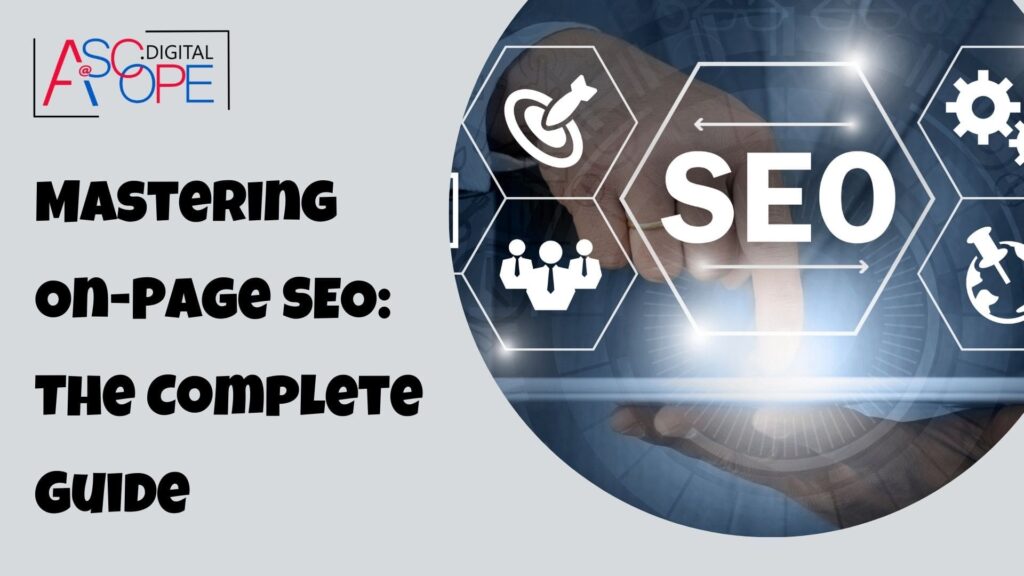In the world of digital marketing, mastering Search Engine Optimization (SEO) is crucial for boosting website visibility and attracting organic traffic. While off-page SEO focuses on external factors like backlinks, on-page SEO revolves around optimizing individual web pages to enhance their search engine rankings. This guide explores essential principles and advanced techniques to effectively master on-page SEO.
Understanding On-Page SEO
On-page SEO involves optimizing various elements within a webpage to improve its search engine rankings. Unlike off-page SEO, which deals with external signals, on-page SEO focuses on content and HTML source code optimizations.
Key Elements of On-Page SEO
Keyword Research and Optimization:
- Keyword Research: Start by identifying relevant keywords using tools like Google Keyword Planner or SEMrush. Choose keywords with adequate search volume and manageable competition.
- Keyword Optimization: Integrate your primary keyword naturally into critical areas such as the title tag, meta description, headers (H1, H2), and throughout the content to improve relevance.
Content Quality and Relevance:
- High-Quality Content: Create original, engaging content that addresses user search intent comprehensively.
- Readability: Use clear headings, subheadings, bullet points, and short paragraphs to enhance readability and user experience.
Meta Tags Optimization:
- Title Tag: Craft a compelling title within 60 characters that includes your primary keyword.
- Meta Description: Write a concise description within 160 characters that entices users to click while incorporating relevant keywords.
URL Structure:
- Keep URLs concise, descriptive, and keyword-rich. Avoid complex parameters and unnecessary characters.
Header Tags (H1, H2, etc.):
- Use header tags to structure content logically. The H1 tag should reflect the main topic and primary keyword, with subsequent tags used for subtopics and related keywords.
Optimized Images and Alt Text:
- Optimize images by compressing them for faster load times. Use descriptive filenames and include relevant keywords in the alt text for better image search optimization.
Internal Linking:
- Incorporate internal links to relevant pages or posts within your website using descriptive anchor text. This helps distribute link equity and improves navigation for users.
User Experience (UX) and Page Speed:
- Ensure your website is mobile-friendly and loads quickly across all devices. Use tools like Google PageSpeed Insights to identify and rectify any performance issues.
Schema Markup:
- Implement schema markup to enhance rich snippets in search results, providing additional context and potentially improving click-through rates.
Social Sharing Integration:
- Include social sharing buttons to facilitate content sharing, potentially increasing visibility and attracting indirect SEO benefits through enhanced engagement.
Advanced Techniques

SEO Audit and Monitoring:
- Conduct regular audits using tools like Google Search Console or SEMrush to identify and rectify on-page SEO issues. Monitor rankings and traffic changes to refine your strategy.
Content Updates and Freshness:
- Keep content relevant and up-to-date to maintain search engine visibility. Regularly update old content and add new posts to demonstrate freshness and relevance.
Structured Data and Rich Snippets:
- Utilize structured data markup for specific content types (e.g., reviews, events) to enhance how your pages appear in search results and potentially improve click-through rates.
Semantic SEO:
- Optimize content for semantic search by focusing on context and user intent. Incorporate related keywords and synonyms naturally to broaden content relevance.
Local SEO Optimization:
- For businesses targeting local markets, optimize your website with local keywords, include business details (address, phone number), and embed a Google Map on the contact page.
Measuring and Analyzing Your SEO Efforts
Measuring the success of your on-page SEO efforts is crucial for continuous improvement. Utilize tools like Google Analytics and Search Console to track key performance indicators such as organic traffic, bounce rates, and conversion rates. Pay close attention to user behavior metrics like average session duration and pages per session to understand how engaging your content is. Regularly audit your website for technical SEO issues like broken links, slow page speeds, and mobile usability problems, which can adversely affect your rankings. Implement A/B testing for different on-page elements like meta titles, descriptions, and call-to-action buttons to see what resonates best with your audience. This data-driven approach helps you identify what works and what doesn’t, enabling you to make informed adjustments. Thus, improving traffic and sales for your website. Read more on the other reasons why your website isn’t getting traffic. By consistently analyzing and refining your SEO strategies, you can stay ahead of the competition and ensure long-term success
Conclusion:
Mastering on-page SEO requires a strategic approach combining technical optimization with user-centric content creation. By implementing these strategies and staying abreast of SEO best practices, you can enhance your website’s visibility, attract organic traffic, and achieve your digital marketing objectives. Remember, SEO is an ongoing effort that demands continuous refinement and adaptation to remain competitive in search engine rankings.
For personalized SEO strategies tailored to your business needs, contact us at [Your Company Name] today!


